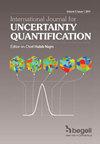Likelihood and depth-based criteria for comparing simulation results with experimental data, in support to validation of numerical simulators
IF 1.8
4区 工程技术
Q2 ENGINEERING, MULTIDISCIPLINARY
International Journal for Uncertainty Quantification
Pub Date : 2023-01-01
DOI:10.1615/int.j.uncertaintyquantification.2023046666
引用次数: 0
Abstract
Within the framework of Best-Estimate-Plus-Uncertainty approaches, the assessment of model parameter uncertainties, associated with numerical simulators, is a key element in safety analysis. The results (or outputs) of the simulation must be compared and validated against experimental values, when such data is available. This validation step, as part of the broader Verification, Validation and Uncertainty Quantification process, is required to ensure a reliable use of the simulator for modeling and prediction. This work aims to define quantitative criteria to support this validation for multivariate outputs, while taking into account modeling uncertainties (uncertain input parameters) and experimental uncertainties (measurement uncertainties). For this purpose, different statistical indicators, based on likelihood or statistical depths, are investigated and extended to the multidimensional case. First, the properties of the criteria are studied, either analytically or by simulation, for some specific cases (Gaussian distribution for experimental uncertainties, identical distributions of experiments and simulations, particular discrepancies). Then, some natural extensions to multivariate outputs are proposed, with guidelines for practical use depending on the objectives of the validation (strict/hard or average validation). From this, transformed criteria are proposed to make them more comparable and less sensitive to the dimension of the output. It is shown that these transformations allow for a fairer and more relevant comparison and interpretation of the different criteria. Finally, these criteria are applied to a code dedicated to nuclear material behavior simulation.将模拟结果与实验数据进行比较的基于似然和深度的标准,以支持数值模拟器的验证
在最佳估计加不确定性方法的框架内,与数值模拟器相关的模型参数不确定性评估是安全分析的关键因素。当有实验数据时,必须将模拟的结果(或输出)与实验值进行比较和验证。这个验证步骤,作为更广泛的验证、验证和不确定度量化过程的一部分,是确保模拟器可靠地用于建模和预测所必需的。这项工作旨在定义定量标准,以支持多变量输出的验证,同时考虑到建模不确定性(不确定输入参数)和实验不确定性(测量不确定性)。为此目的,根据可能性或统计深度调查不同的统计指标,并将其扩展到多维情况。首先,对某些特定情况(实验不确定性的高斯分布,实验和模拟的相同分布,特殊差异)的准则性质进行了分析或模拟研究。然后,提出了对多变量输出的一些自然扩展,并根据验证的目标(严格/硬验证或平均验证)提供了实际使用的指导方针。在此基础上,提出了转换后的标准,使它们更具可比性,并且对输出的维度不那么敏感。报告显示,这些转变使得对不同标准的比较和解释更加公平和相关。最后,将这些准则应用于核材料行为模拟程序。
本文章由计算机程序翻译,如有差异,请以英文原文为准。
求助全文
约1分钟内获得全文
求助全文
来源期刊

International Journal for Uncertainty Quantification
ENGINEERING, MULTIDISCIPLINARY-MATHEMATICS, INTERDISCIPLINARY APPLICATIONS
CiteScore
3.60
自引率
5.90%
发文量
28
期刊介绍:
The International Journal for Uncertainty Quantification disseminates information of permanent interest in the areas of analysis, modeling, design and control of complex systems in the presence of uncertainty. The journal seeks to emphasize methods that cross stochastic analysis, statistical modeling and scientific computing. Systems of interest are governed by differential equations possibly with multiscale features. Topics of particular interest include representation of uncertainty, propagation of uncertainty across scales, resolving the curse of dimensionality, long-time integration for stochastic PDEs, data-driven approaches for constructing stochastic models, validation, verification and uncertainty quantification for predictive computational science, and visualization of uncertainty in high-dimensional spaces. Bayesian computation and machine learning techniques are also of interest for example in the context of stochastic multiscale systems, for model selection/classification, and decision making. Reports addressing the dynamic coupling of modern experiments and modeling approaches towards predictive science are particularly encouraged. Applications of uncertainty quantification in all areas of physical and biological sciences are appropriate.
 求助内容:
求助内容: 应助结果提醒方式:
应助结果提醒方式:


